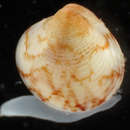pt-BR
nomes no trilho de navegação


Die Venerida sind eine Ordnung der Muscheln (Bivalvia), die zur Überordnung Heterodonta innerhalb der Unterklasse Autolamellibranchiata gerechnet wird. Die ersten Vertreter dieser Gruppe sind aus dem Ordovizium bekannt. Sie dürfte eine der umfangreichsten Ordnungen der Muscheln sein.
Die Gehäuse der Venerida sind mit wenigen Ausnahmen meist gleichklappig. Die Schale ist aragonitisch mit vorwiegend kreuzlamellaren und prismatischen Mikrostrukturen ohne Perlmuttlagen. Das Schloss ist meist gut ausgebildet, kann aber auch in einigen Gruppen weitgehend reduziert sein. Die Schließmuskeln sind meist isomyar.
Entsprechend der großen Diversität gibt es die unterschiedlichsten Lebensweisen. Vorherrschend ist jedoch das Graben in Weichsediment. Andere Formen liegen auf dem Sediment und leben in Symbiose mit Algen. Die überwiegende Mehrzahl der Venerida lebt im Meer, einige wenige Gruppen sind jedoch auch ins Süßwasser vorgedrungen.
Die Ordnung wird in etwa 13 bis 17 Überfamilien untergliedert:
Aktuelle Entwicklungen: Bieler & Mikkelsen (2006) haben noch die folgenden Überfamilien in die Ordnung Venerida transferiert.
In den bisherigen Klassifikationen sind sie noch zur Ordnung Myida gestellt.
Die Überfamilie
Die Venerida sind eine Ordnung der Muscheln (Bivalvia), die zur Überordnung Heterodonta innerhalb der Unterklasse Autolamellibranchiata gerechnet wird. Die ersten Vertreter dieser Gruppe sind aus dem Ordovizium bekannt. Sie dürfte eine der umfangreichsten Ordnungen der Muscheln sein.
Venerida (formerly Veneroida) is an order of mostly saltwater but also some freshwater bivalve molluscs. This order includes many familiar groups such as many clams that are valued for food and a number of freshwater bivalves.
Since the 2000s, the taxonomy currently represented in the World Register of Marine Species (WoRMS) classifies several taxa contained in the former Veneroida into other orders, such as the new Cardiida (for Cardioidea and Tellinoidea) and Carditida (cockles and their allies).[1][2]
Venerids are generally thick-valved, equal-valved and isomyarian (that is, their adductor muscles are of equal size). Three main hinge teeth are characteristic of the subclass Heterodonta, to which this order belongs. Many species are active rather than sessile. However, they tend to be filter feeders, feeding through paired siphons, with a characteristic folded gill structure adapted to that way of life.
In 2002, Gonzalo Giribet and Ward Wheeler suggested that the orders Myoida and Veneroida were not monophyletic.[3] They have since been widely reorganised.
Order: Venerida
Venerida (formerly Veneroida) is an order of mostly saltwater but also some freshwater bivalve molluscs. This order includes many familiar groups such as many clams that are valued for food and a number of freshwater bivalves.
Since the 2000s, the taxonomy currently represented in the World Register of Marine Species (WoRMS) classifies several taxa contained in the former Veneroida into other orders, such as the new Cardiida (for Cardioidea and Tellinoidea) and Carditida (cockles and their allies).
Les Venerida (les Vénéroïdes) sont un ordre de mollusques bivalves.
Suivant les classifications, ce taxon est en concurrence avec celui des Veneroida (qui, lorsqu'il est considéré comme valide, regroupe aussi une bonne partie des Cardiida).
Ces espèces présentent des coquilles épaisses, équivalves et souvent non équilatérales. Elles ont des dents cardinales et latérales. Leurs muscles adducteurs sont de tailles sensiblement égales. Leurs crochets se trouvent en position antérieure. Leurs siphons sont plutôt petits et plus ou moins fusionnés.
Selon World Register of Marine Species (1 avril 2016)[1] :
Les Venerida (les Vénéroïdes) sont un ordre de mollusques bivalves.
Suivant les classifications, ce taxon est en concurrence avec celui des Veneroida (qui, lorsqu'il est considéré comme valide, regroupe aussi une bonne partie des Cardiida).